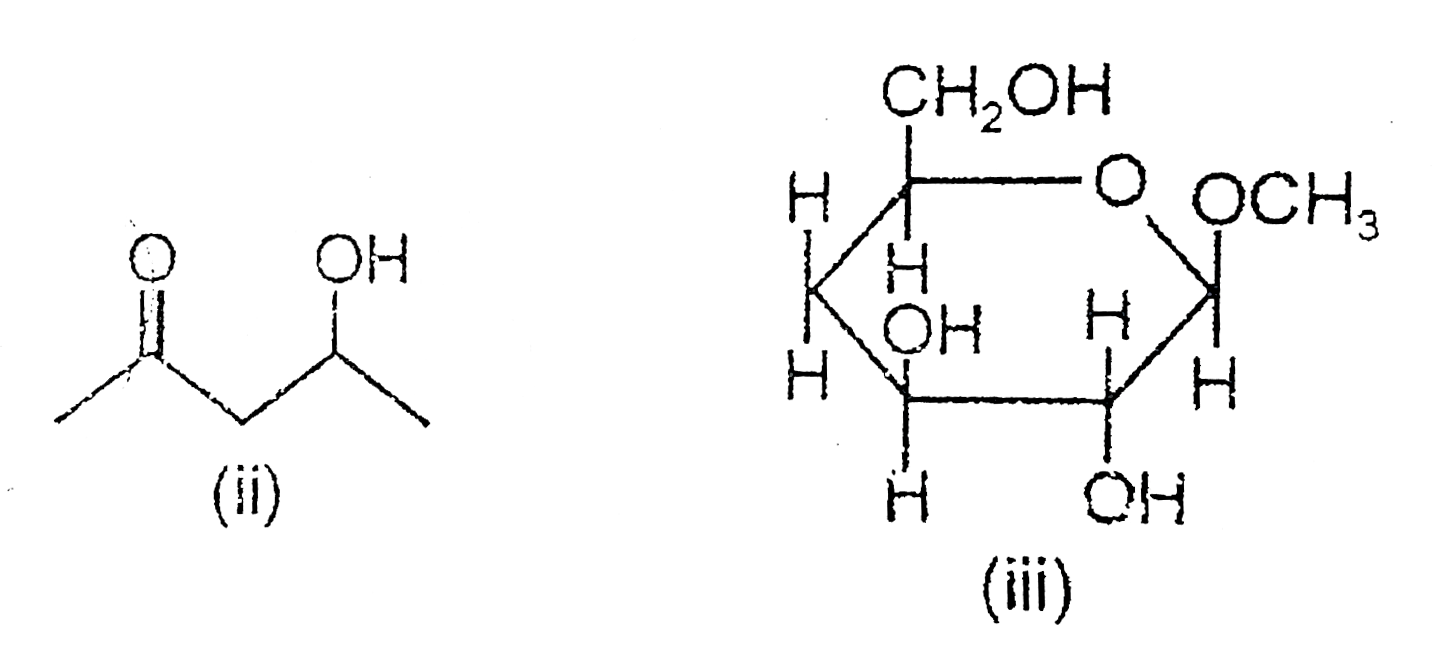Which set of products is expected on reductive ozonolysis of the following diolefin ?
CH3CH=CH3∣C−CH=CH2
CH3CHO,CH3COCH=CH2
CH3CH=C(CH3)CHO,CH2O
CH3CHO,CH3COCHO,CH2O
CH3CHO,CH3COCH3,CH2O
The correct Answer is:C
To determine the products of the reductive ozonolysis of the diolefin given as CH3CH=CH(CH3)CH=CH2, we will follow these steps:
Step 1: Identify the structure of the diolefin
The given diolefin can be represented as follows:
- The structure is:
CH3∣CH3−CH=CH−CH=CH2
This shows that there are two double bonds present in the molecule.
Step 2: Understand the mechanism of ozonolysis
In ozonolysis, the alkene undergoes a reaction with ozone (O3) leading to the formation of an ozonide intermediate. This is a 1,3-cycloaddition reaction where ozone adds across the double bonds.
Step 3: Draw the ozonide intermediate
When the diolefin reacts with ozone, it forms an ozonide. The ozonide can be represented as:
OOO
This ozonide will then undergo cleavage.
Step 4: Perform the retro-aldol reaction
The ozonide will break down (retro-aldol reaction) to yield carbonyl compounds. In this case, the double bonds will break, and we will form two carbonyl compounds (aldehydes or ketones).
Step 5: Determine the products
For the diolefin CH3CH=CH(CH3)CH=CH2, the cleavage will occur at the double bonds, leading to the formation of the following products:
1. Acetone (from the cleavage of the first double bond)
2. Propanal (from the cleavage of the second double bond)
Thus, the expected products from the reductive ozonolysis of the diolefin are:
- Acetone (CH3COCH3)
- Propanal (CH3CHO)
Final Answer:
The set of products expected from the reductive ozonolysis of the diolefin CH3CH=CH(CH3)CH=CH2 is Acetone and Propanal.
---
The given diolefin can be represented as follows:
- The structure is:
CH3∣CH3−CH=CH−CH=CH2
This shows that there are two double bonds present in the molecule.
In ozonolysis, the alkene undergoes a reaction with ozone (O3) leading to the formation of an ozonide intermediate. This is a 1,3-cycloaddition reaction where ozone adds across the double bonds.
When the diolefin reacts with ozone, it forms an ozonide. The ozonide can be represented as:
OOO
This ozonide will then undergo cleavage.
The ozonide will break down (retro-aldol reaction) to yield carbonyl compounds. In this case, the double bonds will break, and we will form two carbonyl compounds (aldehydes or ketones).
For the diolefin CH3CH=CH(CH3)CH=CH2, the cleavage will occur at the double bonds, leading to the formation of the following products:
1. Acetone (from the cleavage of the first double bond)
2. Propanal (from the cleavage of the second double bond)
- Acetone (CH3COCH3)
- Propanal (CH3CHO)
The set of products expected from the reductive ozonolysis of the diolefin CH3CH=CH(CH3)CH=CH2 is Acetone and Propanal.
Topper's Solved these Questions
- BOOK - MOTIONCHAPTER - HYDROCARBON EXERCISE - Exercise - 2 (Level-I)29videos
HYDROCARBON
- BOOK - MOTIONCHAPTER - HYDROCARBON EXERCISE - Exercise - 314videos
HYDROCARBON
- BOOK - MOTIONCHAPTER - HYDROCARBON EXERCISE - QUESTIONS6videos
HYDROCARBON
- BOOK - MOTIONCHAPTER - GRIGNARD REAGENTEXERCISE - EXERCISE-216videos
GRIGNARD REAGENT
- BOOK - MOTIONCHAPTER - IONIC EQUILIBRUIMEXERCISE - Exercise -4 (Level -II)14videos
IONIC EQUILIBRUIM
Similar Questions
Knowledge Check
- Question 1 - Select One
The major product of the following reaction, (CH3)2CH−NH2∣CH−CH3HNO2−−−→ is
A(CH3)2CH−NOH∣∣C−CH3B C(CH3)2CH−OH∣CH−CH3D(CH3)2CH−N=NOH∣CH−CH3
C(CH3)2CH−OH∣CH−CH3D(CH3)2CH−N=NOH∣CH−CH3 - Question 2 - Select One
The products formed during the following reaction are :
CH3−CH3∣C∣CH3−O−CH3+HI→?ACH3OH+CH3−CH3∣C∣CH3−IBCH4+CH3−CH3∣C∣CH3−OICCH3I+CH3−CH3∣C∣CH3−OHDCH3OI+CH3−CH3∣C∣CH3−H - Question 3 - Select One
Which is the most suitable reagent for the following transformation ?
CH3−CH=CH−CH2−OH∣CH−CH3→CH3−CH=CH−CH2CO2HACrO2Cl2/CS2Balkaline KMnO4CTollen's reagentDI2/NaOH
Give the products of the following reactions : –
CH3−CH3∣C∣CH3−CH=CH2HBr−−→
3, 3-dimethyl - 1 - buteneView SolutionThe major product of the following reaction is
CH3−CH=CH−O∣∣C−O−CH3LiAlH4−−−→View SolutionWhich of these reagents would accomplish the following reduction?
N≡C−CH2−O∣∣C−CH2−CH=CH2→N≡C−CH2−OH∣CH−CH2−CH=CH2View SolutionIn which of the following reduction of Tollen's reagent take place CH3−O∣∣C−CH3
 View Solution
View SolutionOzonolysis of CH3—CH=C=CH2 will give
View Solution


